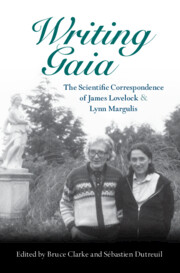Book contents
- Writing Gaia: The Scientific Correspondence of James Lovelock and Lynn Margulis
- Reviews
- Writing Gaia: The Scientific Correspondence of James Lovelock and Lynn Margulis
- Copyright page
- Epigraph
- Table of Contents
- Figures
- Contributors
- Foreword by James Lovelock
- Preface
- Acknowledgements
- Introduction
- Part I 1970–1972
- 1970
- 1971
- 1972
- Part II 1973–1979
- Part III 1980–1991
- Part IV 1992–2007
- Part V Commentaries on Lovelock and Margulis
- Glossary of Names
- Glossary of Terms
- Bibliography
- Index
1971
from Part I - 1970–1972
Published online by Cambridge University Press: 28 July 2022
- Writing Gaia: The Scientific Correspondence of James Lovelock and Lynn Margulis
- Reviews
- Writing Gaia: The Scientific Correspondence of James Lovelock and Lynn Margulis
- Copyright page
- Epigraph
- Table of Contents
- Figures
- Contributors
- Foreword by James Lovelock
- Preface
- Acknowledgements
- Introduction
- Part I 1970–1972
- 1970
- 1971
- 1972
- Part II 1973–1979
- Part III 1980–1991
- Part IV 1992–2007
- Part V Commentaries on Lovelock and Margulis
- Glossary of Names
- Glossary of Terms
- Bibliography
- Index
Summary
Lovelock’s next letter to Margulis in our record, dated New Year’s Day, 1971, refers again to the draft beginnings of a professional paper: “The paper is by no means finished but I enclose for your interest the section dealing with the state of oxidation, which should indicate the way of thought” (Letter 2). However, his correspondence with Margulis did not mention “Gaia” by name until a year later (Letter 11). He seems to have waited for her to confirm her willingness to join him in co-writing a paper, “if it turns out,” she replied, “we have something to say after our talks” (Letter 8). Fully developed papers “on the Earth’s atmosphere as a biological cybernetic system” become the project of their first collaborative writings.
- Type
- Chapter
- Information
- Publisher: Cambridge University PressPrint publication year: 2022

